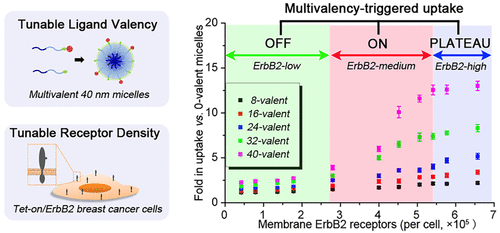Our official English website, www.x-mol.net, welcomes your
feedback! (Note: you will need to create a separate account there.)
Quantitative Study of the Interaction of Multivalent Ligand-Modified Nanoparticles with Breast Cancer Cells with Tunable Receptor Density.
ACS Nano ( IF 15.8 ) Pub Date : 2020-01-14 , DOI: 10.1021/acsnano.9b05689 Jing Wang 1 , Junseon Min 1 , Seyed Ali Eghtesadi 1 , Ravi S Kane 2 , Ashutosh Chilkoti 1
ACS Nano ( IF 15.8 ) Pub Date : 2020-01-14 , DOI: 10.1021/acsnano.9b05689 Jing Wang 1 , Junseon Min 1 , Seyed Ali Eghtesadi 1 , Ravi S Kane 2 , Ashutosh Chilkoti 1
Affiliation

|
Multivalent nanoparticles that target a cell surface receptor that is overexpressed by cancer cells are a promising delivery system for cancer therapy. However, the impact of the receptor density and nanoparticle ligand valency on the cell uptake has not been studied in a system where both variables can be systematically tuned over a wide range. To address this lacuna, we report cell-uptake studies on a genetically engineered breast cancer cell line with tunable ErbB2 expression by a polypeptide micelle with tunable ligand valency. We examined the uptake of ErbB2-targeting micelles at 5 ligand densities and 11 receptor densities. We identified a matching pattern between receptors and ligands in which a receptor-to-ligand density ratio of 0.7-4.5 and a minimum of ∼1.6 bonds are required to initiate receptor-mediated endocytosis. Lower and upper limits of receptor density in the cell-uptake profile suggested a standard by which to categorize breast cancer patients as ErbB2-low, ErbB2-medium, and ErbB2-high, with each group expected to respond differently to multivalent therapeutic nanoparticles. At ErbB2-medium and ErbB2-high levels, increasing the ligand valency to 40-valent ErbB2-targeting peptides for a 20 nm radius nanoparticle accelerated the cell uptake, suggesting that the use of nanoparticles with high ligand valency for drug delivery will greatly benefit patients in these two groups. This study advances our understanding of how to rationally optimize nanotechnology for targeted drug delivery.
中文翻译:

多价配体修饰的纳米粒子与具有可调受体密度的乳腺癌细胞相互作用的定量研究。
靶向癌细胞过度表达的细胞表面受体的多价纳米粒子是用于癌症治疗的有希望的递送系统。但是,尚未在两个变量均可在较宽范围内系统调节的系统中研究受体密度和纳米粒子配体价对细胞摄取的影响。为了解决这一空白,我们报告了通过具有可调配体价的多肽胶束对具有可调ErbB2表达的基因工程乳腺癌细胞系进行细胞摄取研究。我们在5个配体密度和11个受体密度下检查了靶向ErbB2的胶束的摄取。我们确定了受体与配体之间的匹配模式,其中受体与配体的密度比为0.7-4.5,最低需要约1.6个键才能启动受体介导的内吞作用。细胞摄取概况中受体密度的上限和下限提出了一个将乳腺癌患者分类为ErbB2低,ErbB2中和ErbB2高的标准,每个组对多价治疗性纳米颗粒的反应不同。在高ErbB2和ErbB2的水平下,将半径20 nm的纳米颗粒的配体化合价提高至40价ErbB2靶向肽可加速细胞吸收,这表明使用具有高配体化合价的纳米颗粒进行药物递送将极大地使患者受益在这两组中。这项研究提高了我们对如何合理优化用于靶向药物输送的纳米技术的理解。每组对多价治疗性纳米颗粒的反应不同。在高ErbB2和ErbB2的水平下,将半径20 nm的纳米颗粒的配体化合价提高至40价ErbB2靶向肽可加速细胞吸收,这表明使用具有高配体化合价的纳米颗粒进行药物递送将极大地使患者受益在这两组中。这项研究提高了我们对如何合理优化用于靶向药物输送的纳米技术的理解。每组对多价治疗性纳米颗粒的反应不同。在高ErbB2和ErbB2的水平下,将半径20 nm的纳米颗粒的配体化合价提高至40价ErbB2靶向肽可加速细胞吸收,这表明使用具有高配体化合价的纳米颗粒进行药物递送将极大地使患者受益在这两组中。这项研究提高了我们对如何合理优化用于靶向药物输送的纳米技术的理解。这表明使用具有高配体价的纳米颗粒进行药物递送将极大地有益于这两类患者。这项研究提高了我们对如何合理优化用于靶向药物输送的纳米技术的理解。这表明使用具有高配体价的纳米颗粒进行药物递送将极大地有益于这两类患者。这项研究提高了我们对如何合理优化纳米技术以靶向药物递送的理解。
更新日期:2020-01-15
中文翻译:

多价配体修饰的纳米粒子与具有可调受体密度的乳腺癌细胞相互作用的定量研究。
靶向癌细胞过度表达的细胞表面受体的多价纳米粒子是用于癌症治疗的有希望的递送系统。但是,尚未在两个变量均可在较宽范围内系统调节的系统中研究受体密度和纳米粒子配体价对细胞摄取的影响。为了解决这一空白,我们报告了通过具有可调配体价的多肽胶束对具有可调ErbB2表达的基因工程乳腺癌细胞系进行细胞摄取研究。我们在5个配体密度和11个受体密度下检查了靶向ErbB2的胶束的摄取。我们确定了受体与配体之间的匹配模式,其中受体与配体的密度比为0.7-4.5,最低需要约1.6个键才能启动受体介导的内吞作用。细胞摄取概况中受体密度的上限和下限提出了一个将乳腺癌患者分类为ErbB2低,ErbB2中和ErbB2高的标准,每个组对多价治疗性纳米颗粒的反应不同。在高ErbB2和ErbB2的水平下,将半径20 nm的纳米颗粒的配体化合价提高至40价ErbB2靶向肽可加速细胞吸收,这表明使用具有高配体化合价的纳米颗粒进行药物递送将极大地使患者受益在这两组中。这项研究提高了我们对如何合理优化用于靶向药物输送的纳米技术的理解。每组对多价治疗性纳米颗粒的反应不同。在高ErbB2和ErbB2的水平下,将半径20 nm的纳米颗粒的配体化合价提高至40价ErbB2靶向肽可加速细胞吸收,这表明使用具有高配体化合价的纳米颗粒进行药物递送将极大地使患者受益在这两组中。这项研究提高了我们对如何合理优化用于靶向药物输送的纳米技术的理解。每组对多价治疗性纳米颗粒的反应不同。在高ErbB2和ErbB2的水平下,将半径20 nm的纳米颗粒的配体化合价提高至40价ErbB2靶向肽可加速细胞吸收,这表明使用具有高配体化合价的纳米颗粒进行药物递送将极大地使患者受益在这两组中。这项研究提高了我们对如何合理优化用于靶向药物输送的纳米技术的理解。这表明使用具有高配体价的纳米颗粒进行药物递送将极大地有益于这两类患者。这项研究提高了我们对如何合理优化用于靶向药物输送的纳米技术的理解。这表明使用具有高配体价的纳米颗粒进行药物递送将极大地有益于这两类患者。这项研究提高了我们对如何合理优化纳米技术以靶向药物递送的理解。









































 京公网安备 11010802027423号
京公网安备 11010802027423号